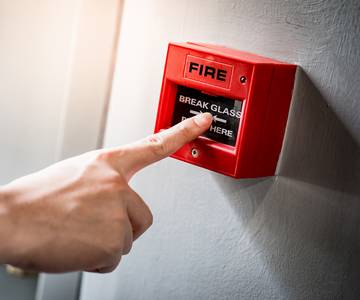
How to Prevent Common Causes of Fire in the Workplace

When you go to work, you expect to be safe while on the job. Your working environment should be secure without the risk of hazard or endangerment. Unfortunately, workplace accidents sometimes occur out of negligence, human errors, or unforeseen circumstances. Out of all the possible accidents, fire hazards are among the most dangerous, and can lead to precarious consequences at work.
Fires spread quickly and unpredictably once they manifest. This type of active accident can harm employees, destroy equipment, and obliterate businesses within moments. Companies need to understand the risks associated with accidental fires. There might be areas in your workplace that present a real threat to fire hazards, which you should identify and rectify as quickly as possible.
Below are four common causes of fire in the workplace, along with the safety measures to prevent them from happening:
Cause #1: Flammable materials stored improperly in the workplace

Depending on the type of business, different combustible materials may accumulate on site. There could be inventory, supplies, or the packaging of both. You might also have scrap material that is the result of your production. All these items are potentially ignitable, increasing the risk of fire hazards in the workplace.
Companies should store any potentially flammable supplies and debris far away from potential ignition sources. Watch out for items like power tools, welders, and other manufacturing equipment. Establish a remote storage space to keep these materials in a safe location. There should also be a comprehensive recycling and disposable system set up to avoid accumulating discarded material.
Being proactive and using proper storage techniques will prevent this main cause of fire in the workplace. Conduct regular inspections of your worksite to ensure that cleanup is ongoing. Instruct staff to look for potential problems before an accident occurs. With the Basic Fire Safety training course, workers will learn to identify fire hazards, understand evacuation procedures, and practice the best safety measures.
Cause #2: Faulty electrical equipment in the workplace

Your office or manufacturing facility may have lots of different electrical devices running at the same time. These productive workplaces might have an increased risk of fire hazards. Many things can go wrong with the wiring of various electrical components, causing a fire to break out in the worksite. Bare or frayed wires pose a real threat to starting fires, as well as improper wiring with poor installations.
Regular inspection and maintenance are vital to keeping the electrical equipment as safe as possible. If your machinery is antiquated, it can easily get overwhelmed with a power surge and malfunction. In some severe cases, the faulty electrical equipment will cause a fire to start in the workplace.
Conduct frequent inspections on all electric-powered tools and equipment used in your operation. Correct any faulty equipment to keep your employees and business safe. In addition, it may be useful to enroll workers in an Electrical Safety Awareness training course. This course trains individuals to recognize common electrical hazards and learn how to mitigate the dangers.
In office settings, be aware of potential hazards associated with portable heaters (tipping / falling onto carpeting or other combustible materials), the overuse of extension cords, or plugging multiple extension cords into each other.
Cause #3: Incorrect use of electrical equipment at work

Even when all your devices and machinery are running smoothly, improper use can set up a situation where workplace fires may occur. Some typical examples include:
- Keeping heaters too close to combustible materials is a common cause of business fires.
- Too much equipment drawing off the same circuits can overload the power, posing a hazardous threat.
- Liquids spilled on electronics or storing combustibles under a computer that can heat up might lead to fire hazards.
- Improper safety procedures using power tools can easily ignite flammable materials in your warehouse or worksite.
- Operating machinery in enclosed spaces can produce a volatile environment for a spark to turn into a raging fire.
Companies can prevent these problems with a comprehensive health and safety training plan. In addition, regular safety meetings with employees will remind those working in high-risk environments to be careful. The purpose of these training sessions or team meetings is to ensure everyone understands the fire hazards and safety procedures. Plan routine workplace inspections checking for these and other potential hazards as an important and necessary incident prevention activity.
Negligence plays into this type of threat because careless behaviour often leads to fire-related accidents. There should never be a reason to take shortcuts and rush a job if it can put someone in danger. Remind your employees not to cut corners to work faster, even if they are behind in deadlines or quotas. Communicate with the team so that they know fire safety comes first in all areas of your workplace.
Cause #4: Arson in the workplace

Sadly, the last cause of a workplace fire on our list is arson. You may be surprised to learn that arson makes up a large percentage of fires. It is also a much trickier incident to avoid. Sometimes, arsons are deliberately caused by disgruntled employees or mischievous vandals. Either way, establishing a robust security system in the workplace is a valuable tool to stop the criminals before they initiate any damage.
CCTV cameras are one way to protect your business from arsonists. The surveillance systems act as both a deterrent and evidence of any heinous act committed on your property. Motion sensor lights also work effectively at turning away any potential threats. Local fire codes dictate fire safety requirements to help protect the workplace from fire hazards. This often includes sprinklers and fire alarm systems.
The above reasons are among the most common causes of fires in the workplace. Be proactive and implement the discussed workplace fire prevention tips to keep you, your staff, and your business protected. Contact Safety First Consulting to learn more about our fire safety training programs. After all, a knowledgeable workforce will be instrumental in identifying, preventing, and responding to fire hazards competently.

